Hibryd III
By Jared B. McComb
Introduction
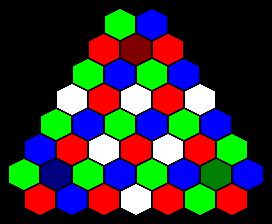
|
Hibryd III is a game played on the board shown at left. It is a three-handed game, the sides being Yellow, Cyan, and Magenta. In addition, there is a neutral faction, Gray, who does not take part in the game and whose pieces can be manipulated by the three players. The board is made of hexagons in the shape of an order-9 triangle with the three corner cells removed. Thus, it has 42 cells. Of the 42 cells, six are white. The remainder of the cells are evenly distributed among the three colors, red, green, and blue. One cell of each color is darker than all the rest; these are called the throne cells. |
Setup
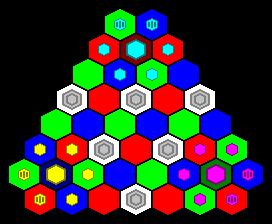
|
This is the opening setup. Each side has seven
pieces, and Gray has six. There are three types
of pieces per player (not including the neutral
pieces); Kings (the large hexagonal pieces),
Pawns (the four small hexagonal pieces in front
of the King), and Knights (the two Pawns in the
back with bars on them.). The Cyan King
occupies the red throne, the Yellow King
occupies the blue throne, and the Magenta
King occupies the green throne. The Gray
Pieces are placed on all the white cells. |
Movement
Movement in this game is limited strictly to orthogonal directions, and much of it is limited to one space per turn. Here are the moves of the pieces:
King
The King may move one space in any orthogonal direction. When put in check, if the player has any Knights adjacent to the King, he may move the King as a Rook out of check. Upon doing so, all Knights that were adjacent to the King -- of any side -- are immediately demoted to Pawns; however, this only works the first time per faction. After the first time, only the adjacent friendly Pawns are demoted. The King may only capture Gray Pieces and other Kings; it must do so by standard Chess capture. The King may not aid Pawns or Knights in capturing. Staying out of check is not obligatory; therefore stalemate does not exist.
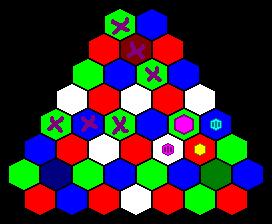
An illustration of the King's escape. The ugly purple X's are legal escape moves for Magenta. In any of these cases, the Magenta and Cyan Knights adjacent to the King would be immediately demoted to Pawns. Note that an escape must be a move of two or more spaces. Pawns
The Pawns may move one space in any direction. Upon reaching an enemy throne or the back row relative to their starting position, they are promoted immediately to Knights. Pawns (and Knights, if present) may only capture Knights and Gray Pieces by 2-way custodianship (as the Pincer Pawns in Ultima) or by 3-way custodianship (surround the piece on three sides in a symmetrical pattern). Pawns may not capture by custodianship with the aid of enemy Pawns or Knights. They may attack (and capture) Kings in the same way that they move. Pawns may not be captured.
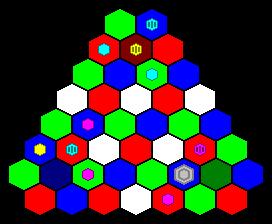
A three-part illustration. The Yellow Knight near the top of the board has been properly captured by three-way custodianship. The Cyan Knight near the lower left has not been captured, because it is surrounded by two enemy factions. The Gray piece towards the lower right has been captured by two-way custodianship. Knights
The Knights may move one space in any direction. They may also move as a Rook (and may capture Kings when so moving), but doing so results in immediate demotion to a Pawn. A Knight is also demoted when captured by custodianship(see above), but is not removed from the board. A Knight may be demoted while on a Pawn-promotion space; it must move onto another in order to re-promote. Knights capture the same way as Pawns, and they may also capture Gray Pieces by orthogonally leaping over them, like in Checkers (or, more appropriately, HexDame). If a Knight moves into a space where it would be captured by custodianship, it is considered to have been thus captured and is immediately demoted.
Gray Pieces
The Gray Pieces may move one space in any direction. If a Gray Piece moves into a space where it would be captured by custodian capture, like a Knight, it is immediately captured by the person that owns the capturing pieces. A Gray Piece may not be moved immediately into the space which the previous player moved it from (this is the Ko rule of the game).
Starting the Game
At the start of the game, no player is assigned to a certain faction; they are chosen in the first three moves. After determining turn order, the first player picks a faction by moving a Pawn from it; the second player then picks a different faction and does the same. The third player takes the remaining faction and also moves a Pawn. Thereafter, all moves are done in the following matter: move a friendly piece, then optionally move a Gray piece.
Winning Conditions
The game can be won in a number of ways.
- Either capture both opposing Kings, or capture the King of the team that previously captured the third King - in other words, have the last King on the board. When a King is captured, the entire faction of that color is removed from the board, and that player takes no more turns.
- Capture four Gray Pieces, using the methods above.
- Promote all of your Pawns to Knights.
- Arrange your six lesser pieces (either Pawns or Knights) in one of the following configurations:
- A straight line;
- An equilateral triangle in which the no pair of pieces is either orthogonally or diagonally adjacent (see below);
- A "close-knit" equilateral triangle that covers three white spaces (see below).
- Arrange your seven pieces in a straight line with the King in the center of it.
- Move your King to the throne of an opposing King.
- Occupy all three thrones with Knights of your color.
Ways 3, 4, and 5 can be countered if the next player can perform the same feat; that method of winning can then no longer be used by any player again, unless the third player can also immediately duplicate the feat, in which case the third player wins. A contering close-knit triangle need not cover three white squares, although a winning one must. Way 6 can be countered in a similar manner; if a player moves his King onto an opposing throne, the only way for the second player to counter is to move their King onto the attacker's throne. If they move their King to the third throne, however, the third player must counter by moving onto the first attacker's throne; if they cannot do so the second player wins.
Some examples of winning configurations:
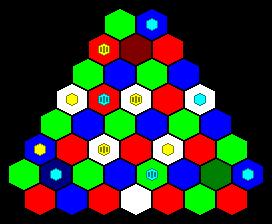
|
An example of two ways of winning with the "equilateral triangle method." Note that no piece of either Yellow or Cyan is orthogonally or diagonally adjacent. Note also that either one of these would act as a counter for another, as they both qualify as the same way of winning. Furthermore, note that either Pawns or Knights may be used in the creation of "alignment" wins. |
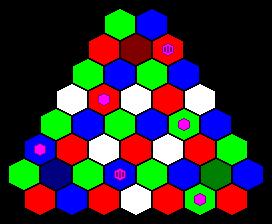
|
A less obvious example of winning this way. Each Magenta piece is a Glinski-Knight's move apart. |
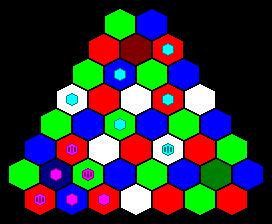
|
An example of two ways that do not count for winning this way. The Magenta team is orthogonally connected, and the Cyan team is diagonally connected. |
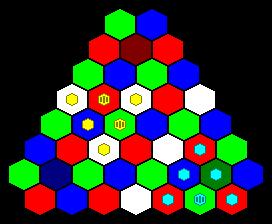
|
An example of the method of winning by a "close-knit" equilateral triangle with three pieces on white spaces. The Yellow team has created a winning position, whereas the Cyan team has not (it lacks the three white squares). However, the Cyan team's triangle may act as a valid counter to Yellow's, if the Cyan team completed their triangle on their next turn, which was directly after Yellow. If it was already sitting there and they just moved their King (who isn't shown) it wouldn't count. |
Null Check
Occasionally, a player may make a move that would end up checking another player with a piece of the third player; this is called 'null check,' because if it is the third player's move next he may not immediately capture the King.
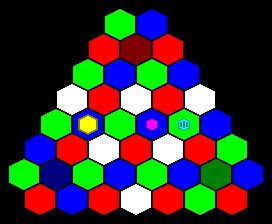
|
An example of null check. If the Magenta Pawn were to move, and it was the Cyan player's turn next, they couldn't immediately capture the Yellow King with their Knight. They could capture it if it were the Magenta King (since he would have put himself in check) or if Yellow had a turn in between and didn't move out of check. |
Credits
This game was invented by Jared B. McComb, and is the third game in a series of games which are amalgamations (hybrids) of other games; hence the name. The word 'hibryd' is misspelled in order to distinguish it as a game (and make it look cool on paper).
This game is a mixture of a miniature version of the board from Triss (a three-handed hexagonal CV), and rules of Chess, HexDame, Teeko, Neutron, and Tafl, as well as numerous games I don't remember the names to and various silly ideas I thought up in my spare time.
Written by Jared B. McComb. HTML Conversion by Peter Aronson.
Please send any comments to:
WWW page created: January 12th, 2002.